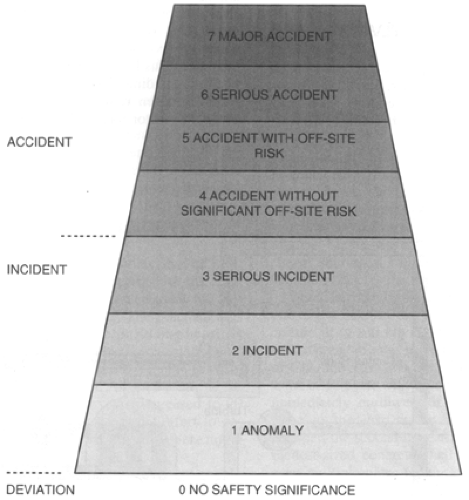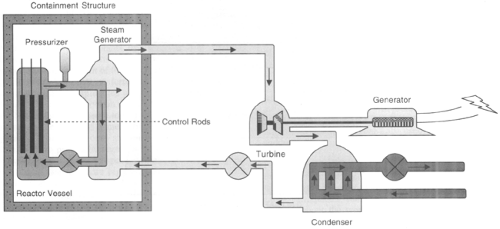Nuclear Power Plant Disasters
Wilfredo Rivera
NAME OF AGENT
Nuclear Power Plant Disaster
THEORETICAL AND SCIENTIFIC BACKGROUND
The first successful nuclear detonation took place in New Mexico in July 1945 as part of the “Manhattan Project” in the United States. Ten years later in June 1955, the first nuclear reactor was unveiled by the former Soviet Union in a town called Obninsk, 60 miles south of Moscow. Since the conception of the nuclear bomb and nuclear powered plants, terrorism associated with these has been a concern of governments and individuals all over the world. After the events on September 11, 2001, in the United States, the concern of a terrorist attack to nuclear power plants, with subsequent dispersal of radiation, has increased significantly.
Radiation dispersal can be achieved by several mechanisms. The ultimate dispersal method is by the detonation of a nuclear weapon (Chapter 18). This will result in explosive destruction along with the massive dispersal of radioactive material, depending on the magnitude of the bomb. The use of conventional explosives mixed with radioactive material is another type of dispersal mechanism (Chapter 17). The use of liquid radioisotopes to be dispersed in the water supply of certain cities has also been considered a possible threat although the amount of material needed to cause large-scale illness is so large that experts believe that this is not a feasible method for an event. The psychological implications of this type of threat are perhaps the most significant and may affect a large number of people in a given area (1,2). Alternatively, an attack on a fixed nuclear facility or on radioactive material in transit may disperse radioactive material in a local region and is considered a possibility in a terrorist attack (2).
TABLE 19-1 U.S. Nuclear Power Plants in Operation | ||||||||||||||||||||||||||||||||||||||||||||||||||||||||||||||||
|---|---|---|---|---|---|---|---|---|---|---|---|---|---|---|---|---|---|---|---|---|---|---|---|---|---|---|---|---|---|---|---|---|---|---|---|---|---|---|---|---|---|---|---|---|---|---|---|---|---|---|---|---|---|---|---|---|---|---|---|---|---|---|---|---|
| ||||||||||||||||||||||||||||||||||||||||||||||||||||||||||||||||
TABLE 19-2 Nuclear Power Plants in Operation around the World as Reported by the Nuclear Energy Institute | ||||||||||||||||||||||||||||||||||||||||||||||||||||||||||||
|---|---|---|---|---|---|---|---|---|---|---|---|---|---|---|---|---|---|---|---|---|---|---|---|---|---|---|---|---|---|---|---|---|---|---|---|---|---|---|---|---|---|---|---|---|---|---|---|---|---|---|---|---|---|---|---|---|---|---|---|---|
|
Nuclear power plants are found in multiple locations around the world. The United States currently has over 100 commercial nuclear power reactors in operation as reported by the Nuclear Regulatory Commission (Table 19-1). Nuclear power plants of different types are also found in many other parts of the world (Table 19-2). The widespread distribution of these power plants enhances the concern of the threat of terrorism. Each nuclear power plant contains multiple sites where radiation could be released. The reactors contain radioactive material that could lead to radiation exposure to surrounding areas if not contained in the event of a meltdown. These nuclear power plant facilities also house storage facilities for spent fuel that can also provide a target for terrorists. Such facilities may vary from spent fuel pools to underground storage in containers that are more highly resistant to direct impact from munitions and from aircraft impacts akin to the attack on the World Trade Center in 2001.
Nuclear safety is a very high priority in all of these power plant facilities. Several incidents have occurred where power plant emergencies have occurred (Table 19-3). With each of these events, communicating risk to the public has become a critical feature of the response. A method for grading these incidents has become widely accepted. Figure 19-1 shows the International Nuclear Event Scale (INES), a tool created to communicate and report to the public in common terms when an event has happened in any nuclear power plant (Fig. 19-1). The scale is divided into seven levels with the lower ones described as incidents and the upper levels termed “accidents.” Most events involving nuclear power plants in history have been described as incidents, and only a handful have met accident criteria. In this chapter we will focus on two main accidents, Chernobyl and Three Mile Island. The Chernobyl accident is considered the worst nuclear power plant accident in history because it had significant health effects, in both the immediate area surrounding the plant and other countries surrounding Chernobyl. Although controversy exists about the health effects of the Chernobyl accident, much of the literature supports that the effects on thyroid cancer and other diseases have been significant following the accident in the areas adjacent to the plant and also remote areas downwind from the accident (3,4,5,6,7,8,9,10,11,12).
TYPES OF REACTORS
Energy production by conventional and nuclear power plants is very similar. The difference is the substrate for the production of heat. Conventional power plants use fossil fuel, oil, gas, or coal to produce heat, which in turn is used to produce power. Nuclear power plants use different radioactive materials with a controlled reaction to produce heat, and this heat is used to produce power.
Nuclear power plants have been controversial since the beginning of the nuclear era. These issues and worries intensified after the September 11, 2001, attack on the landmark towers in New York City in the United States. Nuclear facilities have implemented multiple redundant systems to ensure their safety. In the United States, nuclear power plants are designed with the idea that the deeper nuclear material is placed in the structure, the safer the structure is. Failure of three specific barriers is needed before a release of radioactive material would occur. Fuel rods are lined by steel and buried inside the reactor with the reactor coolant system/pressure vessel that has steel walls about 9 inches thick. The containment building surrounds these structures and is constructed of concrete 3 to 5 feet thick. These facilities are designed to withstand the impact of hurricanes and airborne objects with very substantial force (13,14,15,16).
In 2002, a study based on a computer model found that the structures that house the nuclear reactor fuel (including the dry storage containers) will protect against the release of radiation even if they are struck by a large commercial jetliner (14). Sandia National Labs used an F-4 Phantom jet and hit a similar structure at 480 miles per hour. The jet was completely destroyed, and the maximum penetration to the concrete wall was 2.4 inches. Spent fuels are stored in different locations in dry storage canisters built and tested to withstand extremely severe impacts that include fire, hurricanes, earthquakes, and other extreme forces (14,17).
Throughout the world, several types of nuclear power plants are used for energy production. The most common types are light water reactors, which are divided into pressurized
water reactors and boiling water reactors; heavy water reactors; and graphite-moderated reactors. Other types of reactors are used in experimental installations and submarines, but they are beyond the scope of this chapter. Pressurized water reactors (PWRs) and boiling water reactors (BWRs) are the two reactors currently used in the United States. PWRs keep water under pressure, but this water does not boil. The water from the reactor heats up the water in the steam generator, which in turn produces steam to power the turbine. These two never mix, so any radioactive materials stay in the reactor area (Fig. 19-2). With boiling water reactors, the water boils inside the reactor, which causes the turbines to revolve. The steam is converted back to water in the condenser and is pushed back to the reactor. The water is allowed to boil in the reactor, but the pressures are much smaller in this type of reactor than they are in PWRs (Fig. 19-3).
water reactors and boiling water reactors; heavy water reactors; and graphite-moderated reactors. Other types of reactors are used in experimental installations and submarines, but they are beyond the scope of this chapter. Pressurized water reactors (PWRs) and boiling water reactors (BWRs) are the two reactors currently used in the United States. PWRs keep water under pressure, but this water does not boil. The water from the reactor heats up the water in the steam generator, which in turn produces steam to power the turbine. These two never mix, so any radioactive materials stay in the reactor area (Fig. 19-2). With boiling water reactors, the water boils inside the reactor, which causes the turbines to revolve. The steam is converted back to water in the condenser and is pushed back to the reactor. The water is allowed to boil in the reactor, but the pressures are much smaller in this type of reactor than they are in PWRs (Fig. 19-3).
TABLE 19-3 Nuclear Power Plant Disasters in History | |||||||||||||||||||||
|---|---|---|---|---|---|---|---|---|---|---|---|---|---|---|---|---|---|---|---|---|---|
|
Another type of reactor is the RBMK, which is a Russian acronym for Reactor Bolshoi Moschnosti Kanalynyi; it uses a graphite moderator (Fig. 19-4). The world’s first nuclear power plant in Obninsk was of this type. The coolant is boiling water, like the BWR. The Chernobyl reactor is a reactor of this type. The major advantage of these reactors is the massive amounts of power that can be achieved but its major disadvantage is that the core is so large that it is very difficult to control. After the Chernobyl accident the use of RBMK reactors was discontinued in the United States.
MAJOR NUCLEAR INCIDENTS
THREE MILE ISLAND, PENNSYLVANIA, 1979
The Three Mile Island station is located on 814 acres of an island near the state capital at Harrisburg, near Middletown, Pennsylvania. The reactor is a pressurized light water reactor (Fig. 19-2). The site consists of four reactors, and the accident occurred in the number two reactor. A combination of equipment malfunctions and human error led to a loss of coolant, which precipitated the emergency events. It remains the most significant accident at a U.S. nuclear power plant to date.
On March 28, 1979, at approximately 4:00 A.M. a failure was experienced in the secondary section of the plant. An undetermined failure caused the main pumps that run water to stop running. This in turn prevented the steam generators from removing heat. As a result, the turbine and then the reactor automatically shut down causing the pressure in the primary system to increase. The pressurizer relief valve opened to prevent the pressure to continue rising and become dangerous. This valve should have reclosed after a certain pressure was reached, but it never did, and there were no signals available to the operators to alert them of this situation. In addition to these occurrences, the emergency feedwater system was tested 42 hours prior to the accident. This test consists of closing a valve and then reopening it at the end of the test. This time, for an unknown reason, the valve was not reopened, which prevented the emergency water feeding system from functioning. After several minutes, this malfunction was discovered, and the valve reopened allowing cooling water to flow into the steam generators. The pressure in the primary system continued to rise, and voids, areas where no water is present, began to form in portions of the system where they were not supposed to be. Consequently, the water was redistributed and caused a false reading that the system was full of water. The operators then stopped pumping water in a system that needed water to cool down the fuel in the reactor because of this false reading in the instrumentation. As a result, the nuclear fuel overheated to the point where some of the long metal tubes or jackets that hold the nuclear fuel pellets (made of zirconium) reacted with the water and generated hydrogen. This hydrogen was released into the reactor containment building. Two days after the start of the events, some hydrogen remained, forming a “hydrogen bubble” above the reactor core. The concern at this point was that the
hydrogen could expand and interfere with the flow of cooling water through the core if the reactor pressure decreased. The bubble was reduced by degassing the pressurizer.
hydrogen could expand and interfere with the flow of cooling water through the core if the reactor pressure decreased. The bubble was reduced by degassing the pressurizer.
Stay updated, free articles. Join our Telegram channel

Full access? Get Clinical Tree




